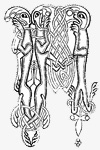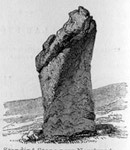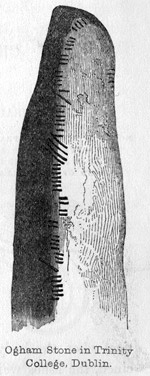Irish Pillar Stones
Stone at Newgrange—Ogham Stones—Perforated Pillar Stones
From A Hand-book of Irish Antiquities by William F. Wakeman
« Cromlechs | Contents | Sepulchral Mounds »
 MANY parts of Ireland, and particularly in districts where the stone circles occur, may be seen huge blocks of stone, which evidently owe their upright position, not to accident, but to the design and labour of an ancient people.
MANY parts of Ireland, and particularly in districts where the stone circles occur, may be seen huge blocks of stone, which evidently owe their upright position, not to accident, but to the design and labour of an ancient people. They are called by the native Irish Gallauns, or Leaganns, and in character they are precisely similar to the hoar-stones of England, the hare-stane of Scotland, and the maen-gwyr of Wales. Many theories have been promulgated relative to their origin. They are supposed to have been idol-stones,—to have been stones of memorial,—to have been erected as landmarks, boundaries, &c.,—and lastly, to be monumental stones. The subject of the illustration is one of several remaining in the neighbourhood of the tumulus of New grange—(see page 21). It measures nine feet in height, and in circumference sixteen. A similar stone in the village of Ballynacraig (i. e., Rock Town), to which it probably gave its name, about half a mile from Newgrange, measures twenty-four feet in circumference, but its present height above the ground is only about six feet. There are monuments of a similar class adjoining the residence of Mr. Grierson, in the valley of Glanismole, about four and a half miles from Dublin. Several of the Irish pillar stones bear inscriptions in the Ogham character, a species of writing supposed to have been in use in this country previous to the introduction of Christianity, but which is occasionally found upon remains of a period long subsequent to the fifth century.
They are called by the native Irish Gallauns, or Leaganns, and in character they are precisely similar to the hoar-stones of England, the hare-stane of Scotland, and the maen-gwyr of Wales. Many theories have been promulgated relative to their origin. They are supposed to have been idol-stones,—to have been stones of memorial,—to have been erected as landmarks, boundaries, &c.,—and lastly, to be monumental stones. The subject of the illustration is one of several remaining in the neighbourhood of the tumulus of New grange—(see page 21). It measures nine feet in height, and in circumference sixteen. A similar stone in the village of Ballynacraig (i. e., Rock Town), to which it probably gave its name, about half a mile from Newgrange, measures twenty-four feet in circumference, but its present height above the ground is only about six feet. There are monuments of a similar class adjoining the residence of Mr. Grierson, in the valley of Glanismole, about four and a half miles from Dublin. Several of the Irish pillar stones bear inscriptions in the Ogham character, a species of writing supposed to have been in use in this country previous to the introduction of Christianity, but which is occasionally found upon remains of a period long subsequent to the fifth century.
As an example of this kind of writing we engrave a portion of an ancient pillar stone, upon which the characters are marked very distinctly. It is preserved in the Museum of Trinity College, and originally stood in the county of Kerry, where stones so inscribed are numerous. Perforated stones, very similar to the ordinary pillar stone, are found in many parts of Ireland, Scotland, and even, as appears from Mr. Wilford's Asiatic Researches, in India. Abroad, as well as at home, their origin is shrouded in the deepest obscurity, nor is it likely that the subject can ever be elucidated.

